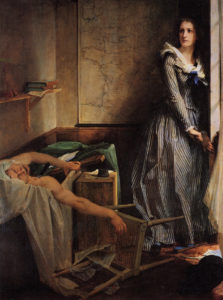1793
The assassination of Jean-Paul Marat
The sanguinary fanaticism of the French Revolution has no representative of such odious and repulsive figure as Marat, the original self-styled ‘Friend of the People.’ By birth a Swiss, of Calvinistic parents, he had led a strange skulking life for five-and-forty years—latterly, a sort of quack mediciner—when the great national crisis brought him to the surface as a journalist and member of the Convention. Less than five feet high, with a frightful countenance, and maniacal eye, he was shrunk from by most people as men shrink from a toad; but he had frantic earnestness, and hesitated at no violence against the enemies of liberty, and so he came to possess the entire confidence and affection of the mob of Paris. His constant cry was for blood; he literally desired to see every well-dressed person put to death. Every day his paper, “L’Ami du Peuple”, was filled with clamorous demands for slaughter, and the wish of his heart was but too well fulfilled.
Such was the opinion of Robert Chambers, the 19th-century encyclopedist and its distaste for Marat has been widely shared by many English-language historians. Marat was not always the blood-thirsty newspaper editor, covered in sores and compelled to spend his days in a soothing tub; he was once a well-respected court physician, political theorist, and amateur scientist, involved in experiments on the nature of light and electricity.
When the French Revolution broke out, Marat attached himself to the more radical elements, using his newspaper L’Ami du Peuple to attack a wide range of conservative and moderate policies and politicians and call for the death of his opponents. He made enemies very easily and was often forced into hiding; his time lurking in Paris sewers may well have aggravated his serious case of dermatitis. By the summer of 1793 the royal family and hundreds of other enemies of the new regime had been sent to the guillotine; Marat clamoured for more executions. On July 13 while soaking in his bath, he was assassinated by Charlotte Corday, a young woman from the provinces and a supporter of a moderate wing of the Revolution which Marat had attacked. She plunged a dagger into his chest — the above painting by is Jacques-Louis David who was called upon to stage the dead man’s lying in state. Radicals expressed their grief by becoming more violent in speech and action; the Terror was not long in coming.
The unrepentant Corday was herself guillotined a few days later.

